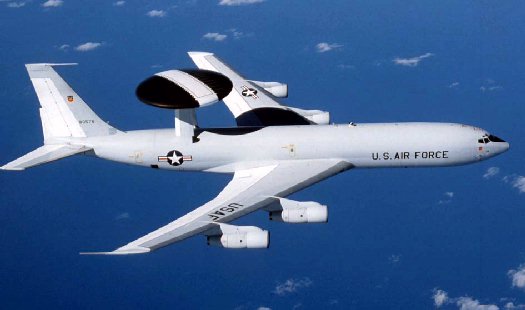E-3 Sentry (AWACS)

Mission
The E-3 Sentry is an airborne warning and control system (AWACS) aircraft that provides all-weather surveillance, command, control and communications needed by commanders of U.S. and NATO air defense forces. As proven in Desert Storm, it is the premier air battle command and control aircraft in the world today.
Features
The E-3 Sentry is a modified Boeing 707/320 commercial airframe with a rotating radar dome. The dome is 30 feet (9.1 meters) in diameter, six feet (1.8 meters) thick, and is held 11 feet (3.3 meters) above the fuselage by two struts. It contains a radar subsystem that permits surveillance from the Earth's surface up into the stratosphere, over land or water. The radar has a range of more than 200 miles (320 kilometers) for low-flying targets and farther for aerospace vehicles flying at medium to high altitudes. The radar combined with an identification friend or foe subsystem can look down to detect, identify and track enemy and friendly low-flying aircraft by eliminating ground clutter returns that confuse other radar systems.
Other major subsystems in the E-3 are navigation, communications and computers (data processing). Consoles display computer-processed data in graphic and tabular format on video screens. Console operators perform surveillance, identification, weapons control, battle management and communications functions.
The radar and computer subsystems on the E-3 Sentry can gather and present broad and detailed battlefield information. Data is collected as events occur. This includes position and tracking information on enemy aircraft and ships, and location and status of friendly aircraft and naval vessels. The information can be sent to major command and control centers in rear areas or aboard ships. In time of crisis, this data can be forwarded to the National Command Authorities in the United States.
In support of air-to-ground operations, the Sentry can provide direct information needed for interdiction, reconnaissance, airlift and close-air support for friendly ground forces. It can also provide information for commanders of air operations to gain and maintain control of the air battle.
As an air defense system, E-3s can detect, identify and track airborne enemy forces far from the boundaries of the United States or NATO countries. It can direct fighter-interceptor aircraft to these enemy targets.
Experience has proven that the E-3 Sentry can respond quickly and effectively to a crisis and support worldwide military deployment operations. It is a jam-resistant system that has performed missions while experiencing heavy electronic countermeasures.
With its mobility as an airborne warning and control system, the Sentry has an excellent chance of surviving in war. Among other things, the flight path can quickly be changed according to mission and survival requirements. The E-3 can fly a mission profile for more than 8 hours without refueling. Its range and on-station time can be increased through inflight refueling.
The aircraft can be used as a surveillance asset in support of other government agencies during counter drug operations. U.S. Customs Service officers may fly aboard the E-3 Sentry on precoordinated missions to detect smuggling activities.
Background
Engineering, test and evaluation began on the first E-3 Sentry in October 1975. In March 1977 the 552nd Airborne Warning and Control Wing (now 552nd Air Control Wing, Tinker Air Force Base, Okla.), received the first E-3s where they are still assigned.
Pacific Air Forces has four E-3 Sentries assigned to the 961st Airborne Air Control Squadron (AACS), Kadena Air Base, Japan, and the 962nd AACS, Elmendorf AFB, Alaska.
NATO has acquired 18 of the aircraft and support equipment. The first E-3 was delivered to NATO in January 1982. The United Kingdom has seven E-3s and France has four.
E-3 Sentry aircraft were among the first to deploy during Operation Desert Shield where they immediately established an around-the-clock radar screen to defend against Iraqi aggression. During Desert Storm, E-3s flew more than 400 missions and logged more than 5,000 hours of on-station time. They provided radar surveillance and control to more than 120,000 coalition sorties. In addition to providing senior leadership with time-critical information on the actions of enemy forces, E-3 controllers assisted in 38 of the 40 air-to-air kills recorded during the conflict.
For the first time in the history of aerial warfare, an entire air war has been recorded. This was due to the data collection capability of the E-3 radar and computer subsystems.
In March 1996, the Air Force activated an AWACS Reserve Associate Program unit which will perform duties on active-duty aircraft. The unit is assigned to the 507th Operations Group at Tinker.
General Characteristics
Primary
Function: Airborne surveillance, command, control and communications
Builder: Boeing
Aerospace Co.
Power
Plant: Four Pratt and Whitney TF33-PW-100A turbofan engines
Thrust: 21,000
pounds each engine
Length: 145
feet, 6 inches (44 meters)
Wingspan: 130
feet, 10 inches (39.7 meters)
Height: 41
feet, 4 inches (12.5 meters)
Rotodome: 30
feet in diameter (9.1 meters), 6 feet thick (1.8 meters), mounted 11 feet
(3.33 meters) above fuselage
Speed: Optimum
cruise 360 mph (Mach 0.48)
Ceiling: Above
29,000 feet (8,788 meters)
Maximum
Takeoff Weight: 347,000 pounds (156,150 kilograms)
Endurance: More
than 8 hours (unrefueled)
Unit
Cost: Approximately $270 million
Crew: Flight
crew of four plus mission crew of 13-19 specialists (mission crew size
varies according to mission)
Date
Deployed: March 1977
Inventory: Active
force, 33; Reserve, 0; Guard, 0
